display RENAULT SCENIC 2009 J84 / 2.G Engine And Peripherals EDC16 Workshop Manual
[x] Cancel search | Manufacturer: RENAULT, Model Year: 2009, Model line: SCENIC, Model: RENAULT SCENIC 2009 J84 / 2.GPages: 273
Page 3 of 273

DIESEL INJECTION
Fault finding – Introduction13B
13B - 3V3 MR-372-J84-13B250$045.mif
EDC16
PROGRAM No: C1
Vdiag No.: 51
Faults
Faults are declared as either present or stored (depending on whether they appeared in a certain context and have
disappeared since, or whether they remain present but have not been diagnosed within the current context).
The present or stored status of faults should be taken into consideration when the diagnostic tool is switched on
after the + after ignition feed (without any system components being active).
For a present fault, apply the procedure described in the Interpretation of faults section.
For a stored fault, note the faults displayed and apply the instructions in the Notes section.
If the fault is confirmed when the instructions in the Notes section are applied, the fault is present. Deal with the fault
If the fault is not confirmed, check:
–the electrical lines which correspond to the fault,
–the connectors for these lines (for oxidation, bent pins, etc.),
–the resistance of the component detected as faulty,
–the condition of the wires (melted or split insulation, wear).
Conformity check
The aim of the conformity check is to check data that does not produce a fault on the diagnostic tool because the
data is inconsistent. Therefore, this stage is used to:
–carry out fault finding on faults that do not have a fault display, and which may correspond to a customer
complaint.
–check that the system is operating correctly and that there is no risk of a fault recurring after repairs.
This section gives the fault finding procedures for statuses and parameters and the conditions for checking them.
If a status is not behaving normally or a parameter is outside the permitted tolerance values, consult the
corresponding fault finding page.
Customer complaints - Fault finding chart
If the test with the diagnostic tool is OK but the customer complaint is still present, the fault should be processed by
customer complaints.
A synopsis of the general procedure to follow is provided on the following page in
the form of a flow chart
Page 11 of 273
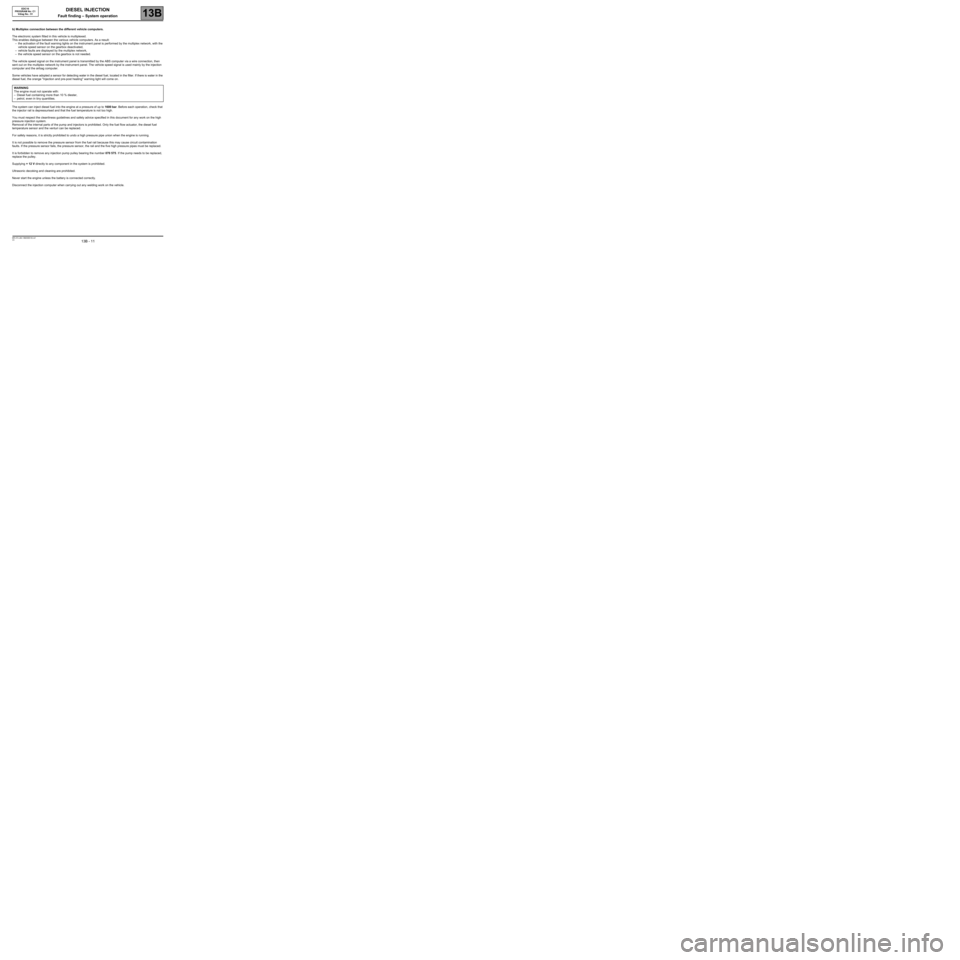
DIESEL INJECTION
Fault finding – System operation13B
13B - 11V3 MR-372-J84-13B250$135.mif
EDC16
PROGRAM No: C1
Vdiag No.: 51
b) Multiplex connection between the different vehicle computers.
The electronic system fitted in this vehicle is multiplexed.
This enables dialogue between the various vehicle computers. As a result:
–the activation of the fault warning lights on the instrument panel is performed by the multiplex network, with the
vehicle speed sensor on the gearbox deactivated,
–vehicle faults are displayed by the multiplex network,
–the vehicle speed sensor on the gearbox is not needed.
The vehicle speed signal on the instrument panel is transmitted by the ABS computer via a wire connection, then
sent out on the multiplex network by the instrument panel. The vehicle speed signal is used mainly by the injection
computer and the airbag computer.
Some vehicles have adopted a sensor for detecting water in the diesel fuel, located in the filter. If there is water in the
diesel fuel, the orange "Injection and pre-post heating" warning light will come on.
The system can inject diesel fuel into the engine at a pressure of up to 1600 bar. Before each operation, check that
the injector rail is depressurised and that the fuel temperature is not too high.
You must respect the cleanliness guidelines and safety advice specified in this document for any work on the high
pressure injection system.
Removal of the internal parts of the pump and injectors is prohibited. Only the fuel flow actuator, the diesel fuel
temperature sensor and the venturi can be replaced.
For safety reasons, it is strictly prohibited to undo a high pressure pipe union when the engine is running.
It is not possible to remove the pressure sensor from the fuel rail because this may cause circuit contamination
faults. If the pressure sensor fails, the pressure sensor, the rail and the five high pressure pipes must be replaced.
It is forbidden to remove any injection pump pulley bearing the number 070 575. If the pump needs to be replaced,
replace the pulley.
Supplying + 12 V directly to any component in the system is prohibited.
Ultrasonic decoking and cleaning are prohibited.
Never start the engine unless the battery is connected correctly.
Disconnect the injection computer when carrying out any welding work on the vehicle.WARNING
The engine must not operate with:
–Diesel fuel containing more than 10 % diester,
–petrol, even in tiny quantities.
Page 14 of 273
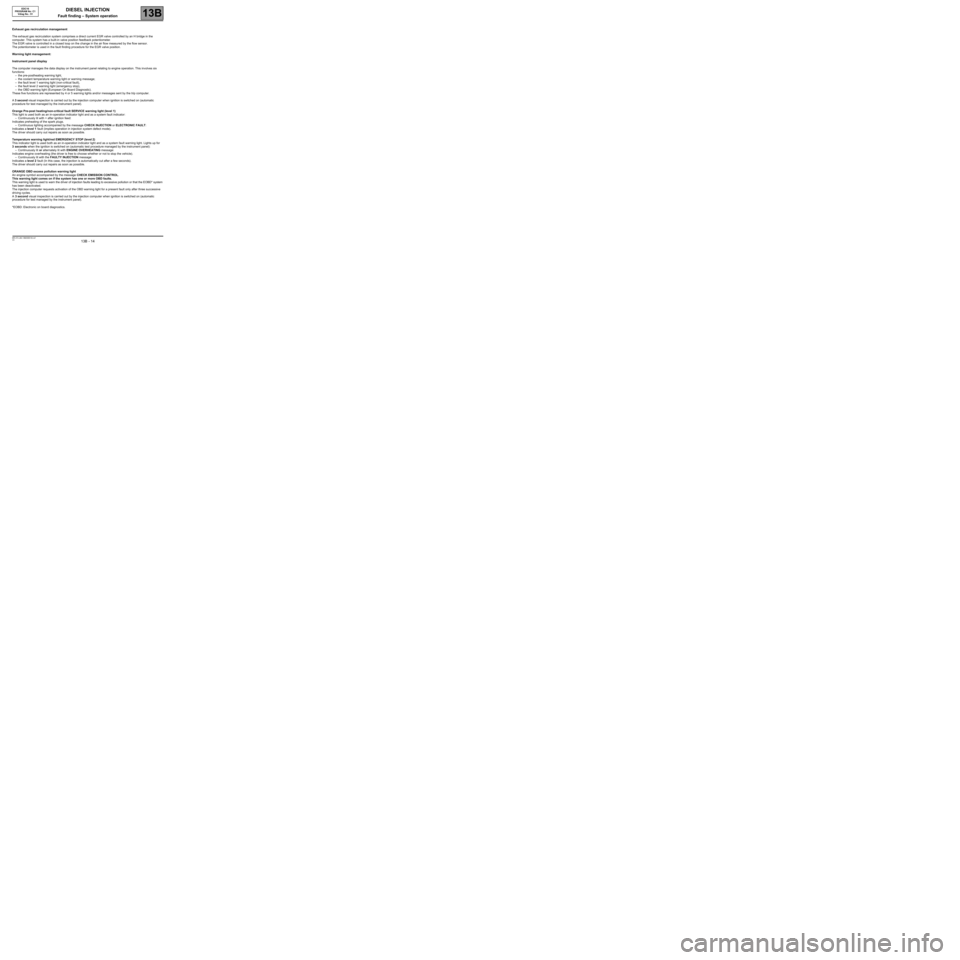
DIESEL INJECTION
Fault finding – System operation13B
13B - 14V3 MR-372-J84-13B250$135.mif
EDC16
PROGRAM No: C1
Vdiag No.: 51
Exhaust gas recirculation management
The exhaust gas recirculation system comprises a direct current EGR valve controlled by an H bridge in the
computer. This system has a built-in valve position feedback potentiometer.
The EGR valve is controlled in a closed loop on the change in the air flow measured by the flow sensor.
The potentiometer is used in the fault finding procedure for the EGR valve position.
Warning light management:
Instrument panel display
The computer manages the data display on the instrument panel relating to engine operation. This involves six
functions:
–the pre-postheating warning light,
–the coolant temperature warning light or warning message;
–the fault level 1 warning light (non-critical fault),
–the fault level 2 warning light (emergency stop),
–the OBD warning light (European On Board Diagnostic).
These five functions are represented by 4 or 5 warning lights and/or messages sent by the trip computer.
A 3 second visual inspection is carried out by the injection computer when ignition is switched on (automatic
procedure for test managed by the instrument panel).
Orange Pre-post heating/non-critical fault SERVICE warning light (level 1)
This light is used both as an in-operation indicator light and as a system fault indicator:
–Continuously lit with + after ignition feed:
Indicates preheating of the spark plugs.
–Continuous lighting accompanied by the message CHECK INJECTION or ELECTRONIC FAULT:
Indicates a level 1 fault (implies operation in injection system defect mode).
The driver should carry out repairs as soon as possible.
Temperature warning light/red EMERGENCY STOP (level 2)
This indicator light is used both as an in-operation indicator light and as a system fault warning light. Lights up for
3 seconds when the ignition is switched on (automatic test procedure managed by the instrument panel):
–Continuously lit or alternately lit with ENGINE OVERHEATING message:
Indicates engine overheating (the driver is free to choose whether or not to stop the vehicle).
–Continuously lit with the FAULTY INJECTION message:
Indicates a level 2 fault (In this case, the injection is automatically cut after a few seconds).
The driver should carry out repairs as soon as possible.
ORANGE OBD excess pollution warning light
An engine symbol accompanied by the message CHECK EMISSION CONTROL.
This warning light comes on if the system has one or more OBD faults.
This warning light is used to warn the driver of injection faults leading to excessive pollution or that the EOBD* system
has been deactivated.
The injection computer requests activation of the OBD warning light for a present fault only after three successive
driving cycles.
A 3 second visual inspection is carried out by the injection computer when ignition is switched on (automatic
procedure for test managed by the instrument panel).
*EOBD: Electronic on board diagnostics.
Page 16 of 273

DIESEL INJECTION
Fault finding – System operation13B
13B - 16V3 MR-372-J84-13B250$135.mif
EDC16
PROGRAM No: C1
Vdiag No.: 51
3. Conditions for clearing an OBD fault
An OBD fault is cleared in several steps.
The fault present in the diagnostic tool is not stored (following repair) until after 3 trips with the vehicle.
The OBD warning light will only light up after these 3 driving cycles.
The warning light coming on does not always mean that there is a fault on the system.
In order that the OBD fault and the display parameters are cleared from the computer, the system needs to
go through 40 engine heating cycles.
An engine heating cycle is a driving cycle during which:
–the engine coolant temperature reaches at least 71.1 ˚C,
–the engine coolant temperature varies by 22.2 °C in relation to the engine starting temperature.
If one of these conditions is not fulfilled, the OBD fault will still be present or stored in the injection computer.
Page 20 of 273
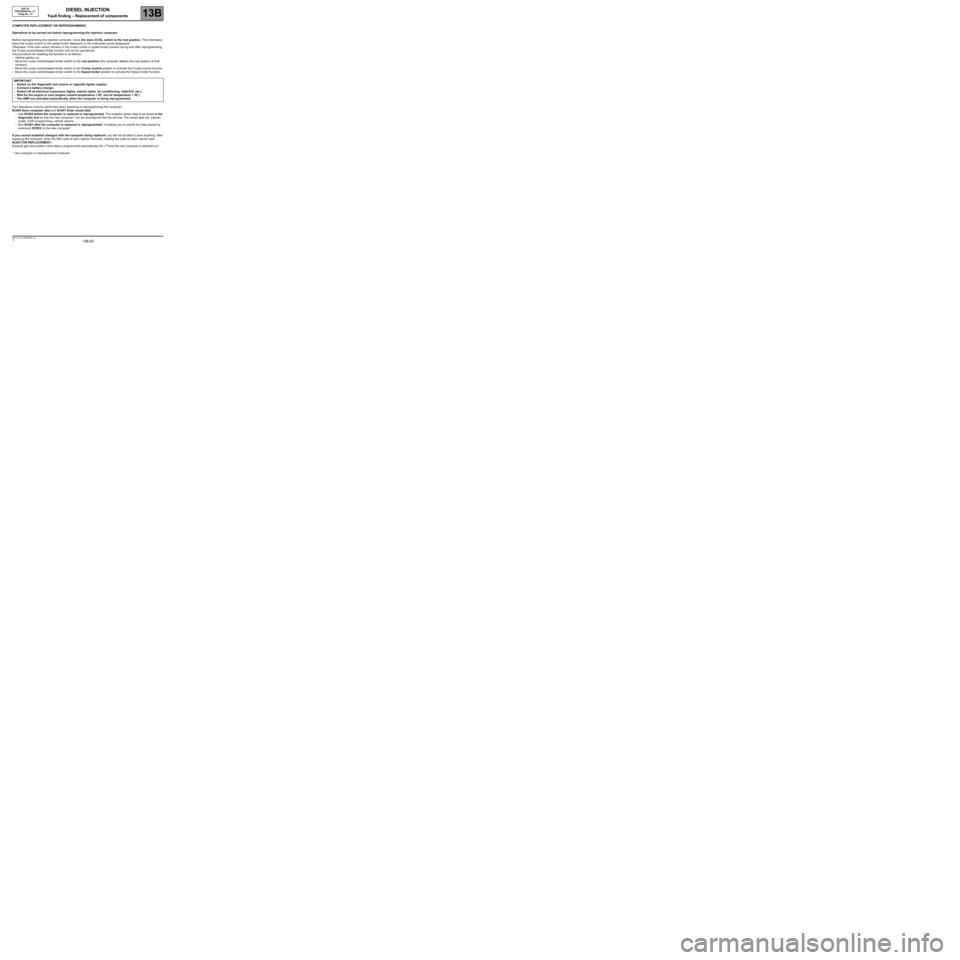
DIESEL INJECTION
Fault finding – Replacement of components13B
13B-20V3 MR-372-J84-13B250$225.mif
EDC16
PROGRAM No: C1
Vdiag No.: 51DIESEL INJECTION
Fault finding – Replacement of components
COMPUTER REPLACEMENT OR REPROGRAMMING
Operations to be carried out before reprogramming the injection computer:
Before reprogramming the injection computer, move the main CC/SL switch to the rest position. The information
about the cruise control or the speed limiter displayed on the instrument panel disappears.
Otherwise, if the main switch remains in the cruise control or speed limiter position during and after reprogramming,
the Cruise control/Speed limiter function will not be operational.
The procedure for resetting the function is as follows:
–Vehicle ignition on.
–Move the cruise control/speed limiter switch to the rest position (the computer detects the rest position at that
moment).
–Move the cruise control/speed limiter switch to the Cruise control position to activate the Cruise control function.
–Move the cruise control/speed limiter switch to the Speed limiter position to activate the Speed limiter function.
Two operations must be performed when replacing or reprogramming the computer:
SC003 Save computer data and SC001 Enter saved data.
–Use SC003 before the computer is replaced or reprogrammed. This enables certain data to be saved in the
diagnostic tool so that the new computer* can be reconfigured like the old one. The saved data are: injector
codes, EGR programming, vehicle options.
–Run SC001 after the computer is replaced or reprogrammed. It enables you to rewrite the data (saved by
command SC003) to the new computer*.
If you cannot establish dialogue with the computer being replaced: you will not be able to save anything. After
replacing the computer, enter the IMA code of each injector manually, reading the code on each injector (see
INJECTOR REPLACEMENT).
Exhaust gas recirculation valve data is programmed automatically the 1
st time the new computer is switched on*.
* new computer or reprogrammed computer. IMPORTANT
–Switch on the diagnostic tool (mains or cigarette lighter supply).
–Connect a battery charger.
–Switch off all electrical consumers (lights, interior lights, air conditioning, radio/CD, etc.).
–Wait for the engine to cool (engine coolant temperature < 60˚ and air temperature < 50˚).
–The GMV are activated automatically when the computer is being reprogrammed.
Page 23 of 273

DIESEL INJECTION
Fault finding – Replacement of components13B
13B-23V3 MR-372-J84-13B250$225.mif
EDC16
PROGRAM No: C1
Vdiag No.: 51
REPLACING OR CLEANING THE EXHAUST GAS RECIRCULATION VALVE (EGR valve)
After the exhaust gas recirculation valve has been replaced or cleaned, the computer must store the new valve's
offset and the offset measured the last time the ignition was switched off, which is when the valve closed.
Using this data, the computer can detect whether the valve is clogged or seized.
When the valve is replaced or cleaned, clear the stored offsets so that the program uses the new valve's offset value.
The data linked to this program is compiled in the Emission control/OBD sub-function.
–PR128: First EGR valve offset.
–PR129: Last EGR valve offset or = PR128 for a new valve.
Programming PR128 and PR129 must be cleared every time the exhaust gas recirculation valve is replaced.
→ PROCEDURE:
–run command SC036 Reset programming;
–select EGR valve as the operation type then follow the instructions given by the diagnostic tool,
When the command is finished,
–switch off the ignition,
–wait 1 minute before switching on the ignition again.
When the ignition is next switched on again the new EGR valve offset is automatically reprogrammed.
–start the vehicle to enable the latest EGR valve offset to be programmed,
–switch off the ignition,
–wait 1 minute before switching on the ignition again.
The last EGR valve offset reprogrammed is stored on the computer.
–then check the system faults, and clear any stored faults;
–otherwise deal with faults which are present and clear the faults in the computer memory.
Carry out a road test followed by a complete check with the diagnostic tool.
End of operation.Note:
When the reinitialisation is completed, the Emission Control/OBD sub-function displays:
PR128 = PR129 > 100%
Note:
When the new EGR valve offset has been reprogrammed, the Emission control/OBD sub-function displays:
10% < PR128 < 40%
PR129 > 100%
Note:
When the last new EGR valve offset has been reprogrammed, theEmission control/OBDsub-function displays:
10% < PR128 < 40%
10% < PR129 < 40%
Page 31 of 273
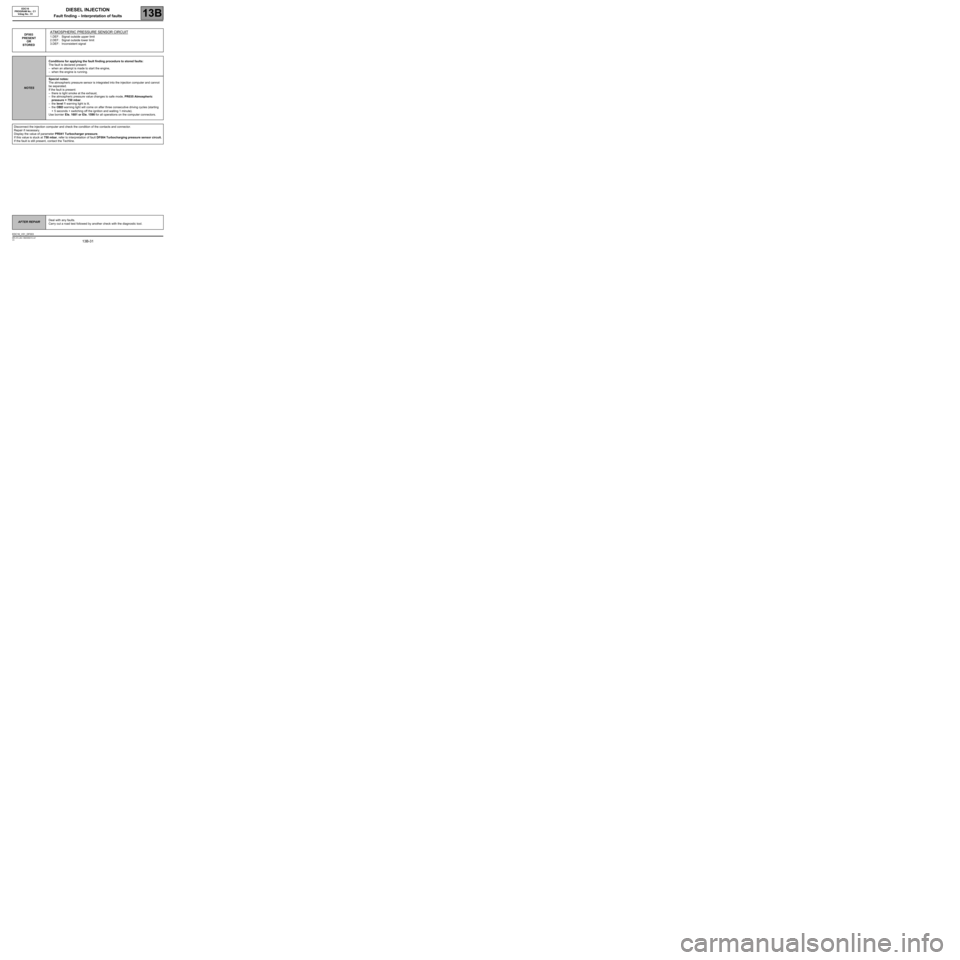
DIESEL INJECTION
Fault finding – Interpretation of faults13B
13B-31V3 MR-372-J84-13B250$315.mif
EDC16
PROGRAM No.: C1
Vdiag No.: 51
DF003
PRESENT
OR
STOREDATMOSPHERIC PRESSURE SENSOR CIRCUIT
1.DEF : Signal outside upper limit
2.DEF : Signal outside lower limit
3.DEF : Inconsistent signal
NOTESConditions for applying the fault finding procedure to stored faults:
The fault is declared present:
–when an attempt is made to start the engine,
–when the engine is running.
Special notes:
The atmospheric pressure sensor is integrated into the injection computer and cannot
be separated.
If the fault is present:
–there is light smoke at the exhaust,
–the atmospheric pressure value changes to safe mode, PR035 Atmospheric
pressure = 750 mbar.
–the level 1 warning light is lit,
–the OBD warning light will come on after three consecutive driving cycles (starting
+ 5 seconds + switching off the ignition and waiting 1 minute).
Use bornier Ele. 1681 or Ele. 1590 for all operations on the computer connectors.
Disconnect the injection computer and check the condition of the contacts and connector.
Repair if necessary.
Display the value of parameter PR041 Turbocharger pressure.
If this value is stuck at 750 mbar, refer to interpretation of fault DF004 Turbocharging pressure sensor circuit.
If the fault is still present, contact the Techline.
AFTER REPAIRDeal with any faults.
Carry out a road test followed by another check with the diagnostic tool.
EDC16_V51_DF003
Page 34 of 273
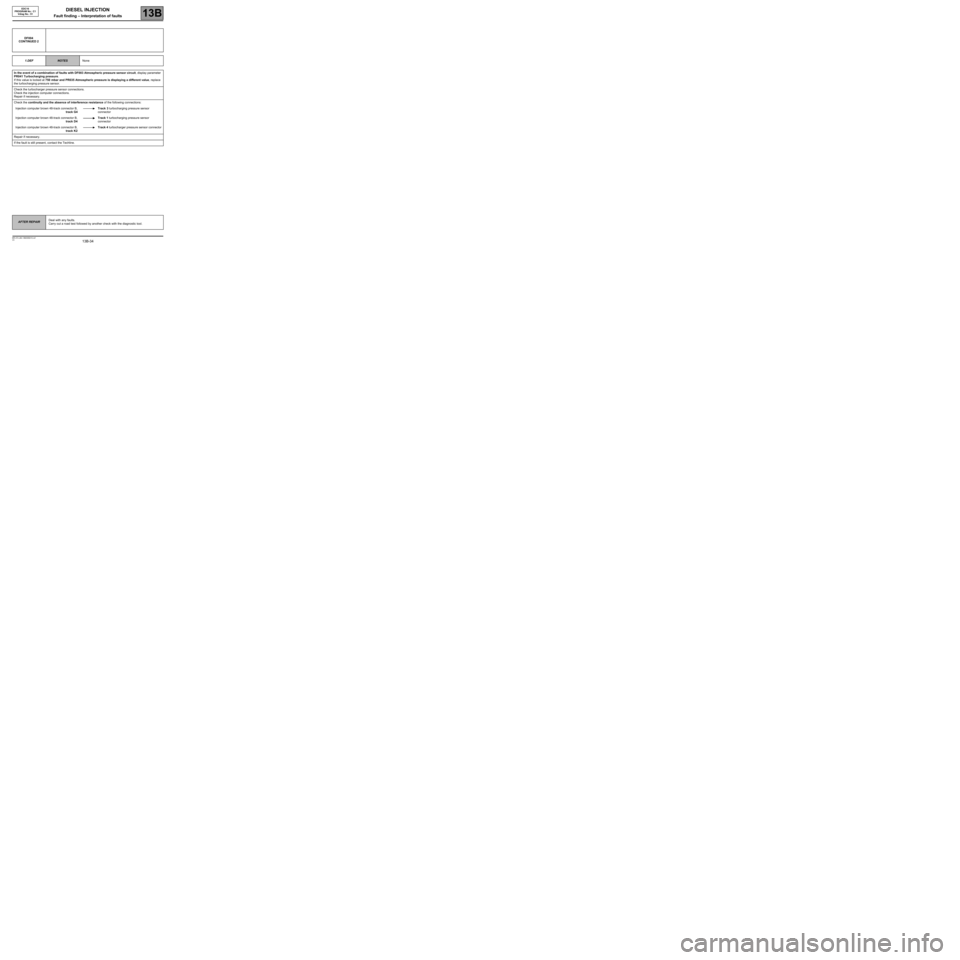
DIESEL INJECTION
Fault finding – Interpretation of faults13B
13B-34V3 MR-372-J84-13B250$315.mif
EDC16
PROGRAM No.: C1
Vdiag No.: 51
DF004
CONTINUED 2
1.DEF
NOTESNone
In the event of a combination of faults with DF003 Atmospheric pressure sensor circuit, display parameter
PR041 Turbocharging pressure.
If this value is locked at 750 mbar and PR035 Atmospheric pressure is displaying a different value, replace
the turbocharging pressure sensor.
Check the turbocharger pressure sensor connections.
Check the injection computer connections.
Repair if necessary.
Check the continuity and the absence of interference resistance of the following connections:
Injection computer brown 48-track connector B,
track G4Track 3 turbocharging pressure sensor
connector
Injection computer brown 48-track connector B,
track D4Track 1 turbocharging pressure sensor
connector
Injection computer brown 48-track connector B,
track K2Track 4 turbocharger pressure sensor connector
Repair if necessary.
If the fault is still present, contact the Techline.
AFTER REPAIRDeal with any faults.
Carry out a road test followed by another check with the diagnostic tool.
Page 38 of 273
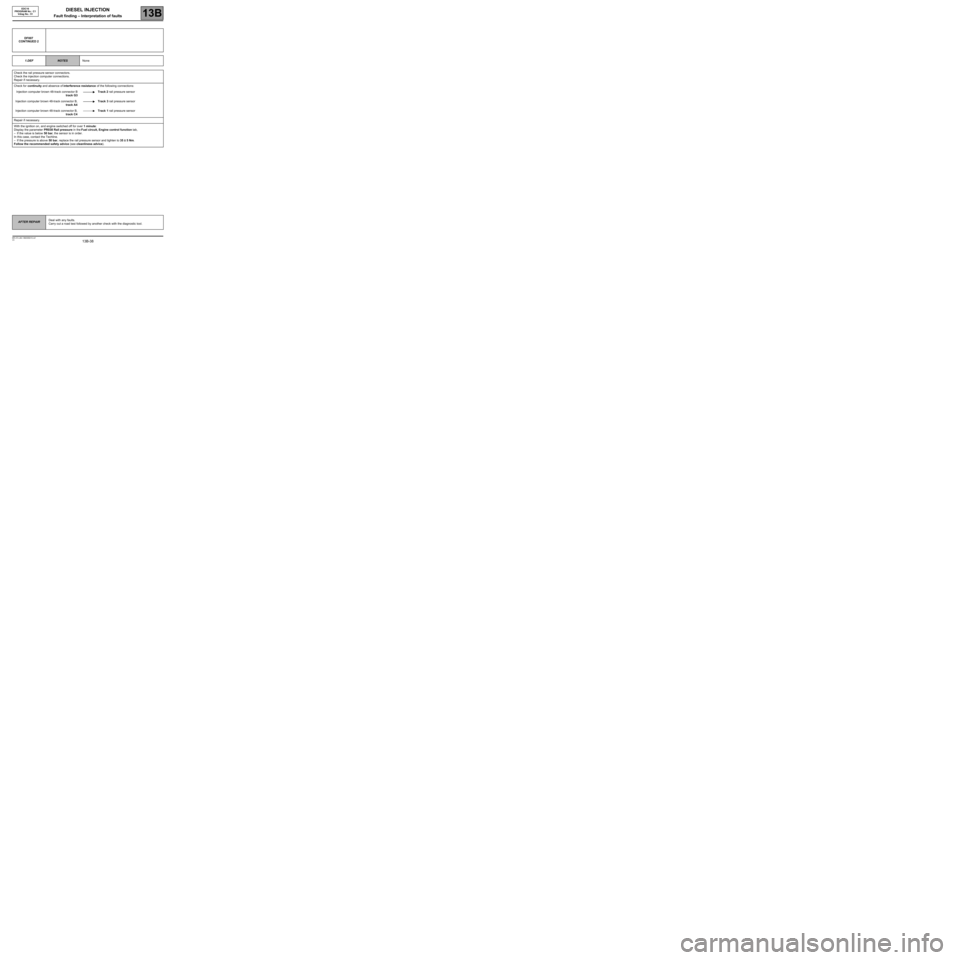
DIESEL INJECTION
Fault finding – Interpretation of faults13B
13B-38V3 MR-372-J84-13B250$315.mif
EDC16
PROGRAM No.: C1
Vdiag No.: 51
DF007
CONTINUED 2
1.DEF
NOTESNone
Check the rail pressure sensor connectors.
Check the injection computer connections.
Repair if necessary.
Check for continuity and absence of interference resistance of the following connections:
Injection computer brown 48-track connector B
track G3Track 2 rail pressure sensor
Injection computer brown 48-track connector B,
track A4Track 3 rail pressure sensor
Injection computer brown 48-track connector B,
track C4Track 1 rail pressure sensor
Repair if necessary.
With the ignition on, and engine switched off for over 1 minute:
Display the parameter PR038 Rail pressure in the Fuel circuit, Engine control function tab,
–If the value is below 50 bar, the sensor is in order.
In this case, contact the Techline.
–If the pressure is above 50 bar, replace the rail pressure sensor and tighten to 35 ± 5 Nm.
Follow the recommended safety advice (see cleanliness advice).
AFTER REPAIRDeal with any faults.
Carry out a road test followed by another check with the diagnostic tool.
Page 41 of 273

DIESEL INJECTION
Fault finding – Interpretation of faults13B
13B-41V3 MR-372-J84-13B250$315.mif
EDC16
PROGRAM No.: C1
Vdiag No.: 51
DF008
CONTINUED 2
1.DEF
NOTESNone
Check the pedal potentiometer connections.
Check the injection computer connections.
Repair if necessary.
Check for continuity and absence of interference resistance of the following connections:
Injection computer black 32-track connector A,
track H2Track 4 pedal potentiometer sensor
Injection computer black 32-track connector A,
track G2Track 3 pedal potentiometer sensor
Injection computer black 32-track connector A,
track H3Track 5 pedal potentiometer sensor
Injection computer black 32-track connector A,
track F3Track 1 pedal potentiometer sensor
Injection computer black 32-track connector A,
track F2Track 2 pedal potentiometer sensor
Injection computer black 32-track connector A,
track F4Track 6 pedal potentiometer sensor
If the fault is still present, replace the pedal potentiometer.
2.DEF
NOTESNone
Check the mechanical condition of the accelerator pedal:
–locked in full load position,
–with the pedal blocked by an external component.
Repair if necessary.
Vary the position of the pedal and refer to the conformity check in order to check the operating values of the
accelerator pedal potentiometer.
If the values displayed are inconsistent, replace the accelerator pedal potentiometer.
AFTER REPAIRDeal with any faults.
Carry out a road test followed by another check with the diagnostic tool.